|
|
|
Sort Order |
|
|
|
Items / Page
|
|
|
|
|
|
|
| Srl | Item |
| 1 |
ID:
178689
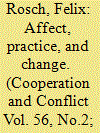

|
|
|
|
|
| Summary/Abstract |
How do practices change? To approach this in practice theory (PT) is a widely debated question. This article brings PT in conversation with the study of emotions in International Relations by considering the role of affect in practice changes. For it is affect that permeates the placiotemporal and bodily constellations during practice performances, continuously provoking changes in and through practices. In initiating this conversation, this article adds to current PT literature by arguing that world political transformations not only find their origin in external conditions, identified as such through individual reflection, but also in affective dynamics of the everyday. To elaborate this more theoretical argument, this article evolves against the empirical backdrop of dancing as an everyday international practice at the Congress of Vienna (1814–1815). Affect that permeated dances in Vienna not only substantiated changes in this practice but, with the waltz replacing the minuet as the preferred dance among international political decision-makers, also changes through it occurred. While the minuet embodied collective sentiments of a transboundary European elite, the waltz helped to further national imaginations of world politics.
|
|
|
|
|
|
|
|
|
|
|
|
|
|
|
|
| 2 |
ID:
142835
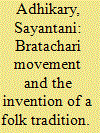

|
|
|
|
|
| Summary/Abstract |
The Bratachari movement, officially inaugurated in 1934, was shaped by the bodily anxieties of educated middle-class Bengalis and aimed at the all-round development of the body, mind and soul through the invention of a specific tradition. Though the founder of the movement, Gurusaday Dutt, attempted to construct a ‘martial’ genealogy for the ‘effeminate’ Bengalis through adequately ‘masculine’, ‘indigenous’ folk dance forms, the ideology around which the movement was built was not entirely ‘indigenous’. Indeed, it seemed to borrow from the English agenda of the revival of folk traditions and the German idea of Volksgeist to a large extent.
|
|
|
|
|
|
|
|
|
|
|
|
|
|
|
|
| 3 |
ID:
155051
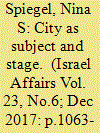

|
|
|
|
|
| Summary/Abstract |
This article investigates the impact of dance on the development of Tel Aviv during the British Mandate of Palestine. It shows how theatrical, salon, and folk dance forms shaped the culture as well as the physical space of the burgeoning city, and how national ideas were encoded into this nexus. The city served as both stage and subject of dancing and choreographic activity.
|
|
|
|
|
|
|
|
|
|
|
|
|
|
|
|
| 4 |
ID:
110335
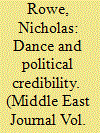

|
|
|
|
|
| Publication |
2011.
|
| Summary/Abstract |
This article examines how the rural folkdance dabkeh has, in the last century, been appropriated and reinvented as a tradition in order to construct the imagined communities of Zionism, pan-Arabism, and Palestinian Nationalism within Palestine/Israel. This appropriation has led to extensive debates and suppositions on the source, meanings, and cultural ownership of dabkeh. The following historical narratives, emerging from interviews with dance practitioners and dance advocates in the West Bank, Israel, and Lebanon, and from literature in libraries and archives in the West Bank, Israel, and Great Britain, draw attention to the salient links between dance and politics and the multiple ways in which collective identities can be constructed and deconstructed. These histories further raise questions about how local cultural autonomy and sustainability within the Occupied Palestinian Territories have been affected by the process of political appropriation.
|
|
|
|
|
|
|
|
|
|
|
|
|
|
|
|
| 5 |
ID:
171298
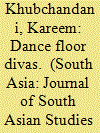

|
|
|
|
|
| Summary/Abstract |
Tracing his encounters with one particular song during fieldwork on queer nightlife in Bangalore, the author argues for the usefulness of ethnography as a critical method for studying dance and other modes of fun, play and pleasure in South Asia. He argues that ethnography’s many modes (co-performance, interview, observation, auto-ethnography) evidence how expressive practices integrate into the multiple strata of everyday life and political-economy, and how these cultural expressions facilitate inventions of new selves and worlds. While popular, improvised and social dances are challenging to study given their ephemerality, ethnography deepens our understanding of them and allows us to engage in creative dialogue in fieldwork.
|
|
|
|
|
|
|
|
|
|
|
|
|
|
|
|
| 6 |
ID:
155048
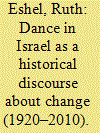

|
|
|
|
|
| Summary/Abstract |
This article discusses the evolution of concert dance in Israel from the 1920s to the current blossoming of the 2010s. The way dance in Israel has evolved reflects the many changes in Israeli society, including ideological, social and political changes, as well as influences of dance genres from abroad, globalisation and post-modernism. The article argues that the engines that have driven dance in Israel along the timeline are change and choices.
|
|
|
|
|
|
|
|
|
|
|
|
|
|
|
|
| 7 |
ID:
124975
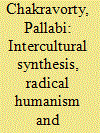

|
|
|
|
|
| Publication |
2013.
|
| Summary/Abstract |
Rabindranath Tagore imbued Indian dance and music with a new modern sensibility. He created novel and eclectic dance-and-music genres, Rabindranritya and Rabindrasangeet, when the national trend was toward classical revivalism. He inspired Indian women to dance on the national stage at a time when dance was associated with immorality and cultural degeneration. This article explores Tagore's song and dance creations, connecting them to his radical political and philosophical thought on universal humanism. Focusing on his views on creativity and freedom, nationalism and cosmopolitanism, and women and essentialism, it is argued that this eclectic intercultural synthesis of ideas served to promote individual consciousness, empowerment and cosmopolitanism without rejecting their Indic cultural roots.
|
|
|
|
|
|
|
|
|
|
|
|
|
|
|
|
| 8 |
ID:
188846
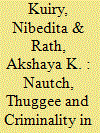

|
|
|
|
|
| Summary/Abstract |
Nineteenth-century colonial India witnessed the much-hyped anti-thuggee campaign, instrumental in creating an elaborate archive of frequent commentaries, opinions on banditry, prisoners and their trials, approvers’ accounts, administrative studies as well as fictional narratives. Re-reading such archival sources, this article explores how nautch, a hybrid form of dance, once glorified and later criminalised by the colonial powers, became a point of intersection between the Europeans in India and local thugs, who often benefitted from such dancers. The article shows the precarious position of the nautch performers as instrumental in collaborating with the colonial rulers and the outlawed thugs for controlling perceived ‘crime’ in the Indian subcontinent, while ending up as victims, too.
|
|
|
|
|
|
|
|
|
|
|
|
|
|
|
|
| 9 |
ID:
170180
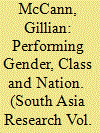

|
|
|
|
|
| Summary/Abstract |
Rukmini Devi Arundale, herself a choreographer and dancer, is considered one of the key figures in re-creating Bharatanatyam. Through her utopian arts colony, Kalakshetra, started during the movement towards Indian independence, she taught what she deemed to be a classical, religious and aesthetically pleasing form of dance. Her rejection of what she termed vulgarity and commercialism in dance reflects her Theosophical worldviews and her class position in a rapidly changing South India. The article examines the ways in which her understanding of Bharatanatyam developed in the context of contested forms of nationalism as a gender regime that contributed to creating proper middle-class, Hindu and Indian subjects. It also examines the impacts of this form of cultural heritage relating to gender, culture and nationalism in today’s globalised South Asian dance scenario.
|
|
|
|
|
|
|
|
|
|
|
|
|
|
|
|
| 10 |
ID:
142501
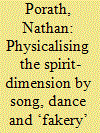

|
|
|
|
|
| Summary/Abstract |
The Orang Sakai of Mainland Riau, on the east coast of Sumatra, have an elaborate performing art genre through which they physicalise the unseen spirit-dimension in a shamanic ritual called dikei. Their shamanic ritual utilises songs, dance as well as comedy. This article elaborates on how songs and dance visualise the unseen beings and provides detailed examples of Sakai performances during which shamans ‘dance with’ or ‘move with’ the spirits. A second theme of the article is the question of the relationship between the meaning of ‘performance’ and fakery, and suggests that there are three types of performed fakery, two of which are accepted as valid and necessary performances which technically contribute to the performance of medicine and the physicalisation of spirit presence.
|
|
|
|
|
|
|
|
|
|
|
|
|
|
|
|
| 11 |
ID:
155056
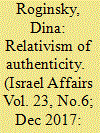

|
|
|
|
|
| Summary/Abstract |
Relying on historic and ethnographic fieldwork, this article traces the development of the Israeli folk dance movement in Israel and the United States over the last century. Israeli folk dances are consumed worldwide and especially by American Jewry precisely because they are perceived as an authentic expression of national Israeli culture, even as their authenticity is continuously contested and re-evaluated in different historical and cultural contexts and by various actors who engage in their preservation and re-creation. The result is an intricate articulation of an ideological and rhetorical debate on authenticity, which reveals its relativistic character and sheds light on the cultural negotiation of identity between Israeli and American Jewry.
|
|
|
|
|
|
|
|
|
|
|
|
|
|
|
|
| 12 |
ID:
091725
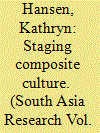

|
|
|
|
|
| Publication |
2009.
|
| Summary/Abstract |
Both the rural-based Nautanki and its urban counterpart, the Parsi theatre, remain part of the cultural scenario of modern India and continue to contribute to the ongoing negotiation of India's composite culture. Part of the appreciation of these older stylized theatre genres comes from awareness of their hybrid character. As emblems of composite culture, these theatrical traditions remind viewers of a popular secular outlook that is still within reach. This article discusses two performances observed during 2004 in New Delhi, of Amar Singh Rathor and Yahudi ki Larki, both canonical popular texts. It is argued that the revival of these plays owes much to their ability to serve as allegories within the current polarized cultural and political climate. The discussion suggests the continuing potential of the impulse to counter neo-nationalist ideology by means of popular media such as Nautanki and Parsi theatre.
|
|
|
|
|
|
|
|
|
|
|
|
|
|
|
|
| 13 |
ID:
159754
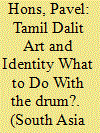

|
|
|
|
|
| Summary/Abstract |
Based mainly on printed sources in Tamil, as well as interviews with Dalit activists, this article seeks to map current divergent attitudes of Dalits towards folklore and especially towards the drum. While most activists argue for the rejection of drumming as a symbol of oppression and untouchability, some try to use it as a means of mobilisation. Others speak in favour of the resignification of the instrument and its protection and preservation as a part of their cultural legacy, which they consider to be different from the mainstream. The article also sets out to correlate these attitudes with the ideology of the eradication of caste and points to the ensuing dilemmas connected with emphasising caste-based identities.
|
|
|
|
|
|
|
|
|
|
|
|
|
|
|
|
| 14 |
ID:
091734
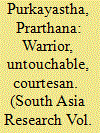

|
|
|
|
|
| Publication |
2009.
|
| Summary/Abstract |
This article analyses the intimate links between dance and the processes of national and postcolonial identity formation in India, particularly in Bengal, in the twentieth century. It examines alternative, non-classical artistic experiments in the realm of theatre dance spawned by twentieth century cultural nationalism in India, focusing on dancing bodies that actively engaged with, and wrote different meanings for, the socio-political space they inhabited. Dance-dramas written by Rabindranath Tagore in the 1930s are used as points of entry into a discourse on South Asian modernism and feminism, opening up a space in which the twentieth century representation of Indian women through bodily performance troubles notions of cultural purity and origin and offers instead 'impure' but nevertheless powerful cultural texts.
|
|
|
|
|
|
|
|
|
|
|
|
|
|
|
|
|
|
|
|
|